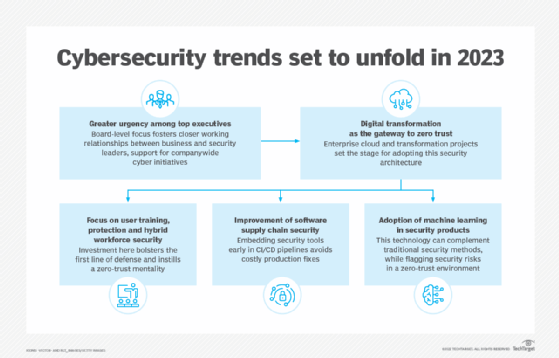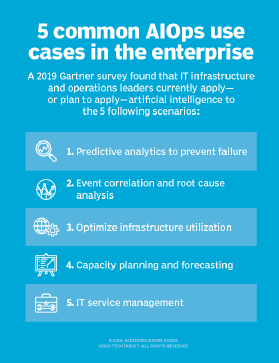
What's next: Predictions, challenges and IT trends for 2023
As organizations look to address ongoing ops skills shortages and increasing complexity in their IT environments, they'll invest in cybersecurity, AI and automation.
Despite layoffs in the tech sector and challenging market conditions, businesses expect to increase their IT spending in 2023, especially related to cybersecurity and AI.
Although the percentage of organizations anticipating budget cuts has increased since last year, over half still plan to spend more on IT in 2023 than in 2022, according to a recent report from TechTarget's Enterprise Strategy Group (ESG). Organizations at more mature stages of digital transformation were especially likely to predict larger IT budgets.
Pushing ahead with digital transformation initiatives
Bill Lundell, director of syndicated research at ESG and author of the report, attributed businesses' willingness to spend on technology to the benefits of their digital transformation efforts. He analogized the current situation to the early days of the COVID-19 pandemic, when some organizations pulled back while others modernized their IT infrastructures.
Since then, companies that made holistic changes to their IT strategy have reaped the benefits -- and those that do the same in the current economic downturn could see similar long-term gains. "It may be a little bit scary, those first couple months or so, but we do have proof that those organizations that have already seen the benefits from digital transformation are not slowing down," Lundell said.
Adopting new technologies amid an economic downturn can be daunting. Especially in more conservative industries and organizations, getting business buy-in for new technologies or a shift to DevOps could be tough for IT teams.
But sticking with what's familiar may not be the best approach in times of crisis. Adopting technologies and practices that improve efficiency and save costs over the long term can give organizations an edge over competitors that hesitate to change their approach.
So, while organizations with less mature digital transformations may be inclined to take a more cautious approach in 2023, "the blueprint says this is when you should commit to making those changes," Lundell said. "No time like the present."
The changing business-IT relationship
IT departments might find greater receptivity to technology initiatives in 2023 as organizations come to view IT ops as core to business success.
Many companies have treated IT as out of sight, out of mind, but attitudes are changing as technology becomes inextricably intertwined with business goals. "Without technology, there's no business in any industry these days," said Bruno Kurtic, chief strategy officer at data analytics vendor Sumo Logic, in a recent panel discussion on DevOps trends in 2023.
ESG analysts had initially expected a focus on reducing operating and capital expenditures in this year's research, according to Lundell. Instead, they saw organizations prioritize strategic initiatives designed to improve business processes and customer experience. Technology projects that support those goals have better odds of getting approval, even in a difficult economic environment.
To identify which IT initiatives have business value, organizations must focus on real-world outcomes -- and analyze results with metrics that are relevant to their particular industry, structure and objectives.
"We cannot do without the technologists, but the technologists cannot exist without the business," said Eveline Oehrlich, research director at IT research and consulting firm Research in Action, in the same panel. "IT is also a business function."
Technology trends in 2023 for IT ops
Cybersecurity is expected to be next year's biggest driver of business IT spending, followed by AI and machine learning, according to ESG's research.
Cloud applications, infrastructure and services are also high on the list. Together with growing interest in automation and observability, these technology areas reflect broader IT trends, such as skills shortages, increasing complexity and escalating cyberthreats.
Cybersecurity
As cyber attacks become more prevalent and costly, spending on cybersecurity has become a necessity in all market conditions. Only 3% of ESG's respondents expected their cybersecurity budgets to shrink in 2023, and IT decision-makers cited improved cybersecurity posture as the top metric for proving the value of tech investments to business management.

But efforts to strengthen cybersecurity have been stymied by the field's ongoing global talent shortage. While the IT skills gap is an industry-wide problem, the situation is especially daunting in cybersecurity: Almost half of respondents reported a lack of security skills in their organization.
Without dedicated cybersecurity personnel, some organizations are treating security as an inherent part of development and IT ops roles. Approaches like DevSecOps integrate security practices into existing workflows rather than handing them off to a separate team.
Managed security services and tools are also becoming indispensable for businesses facing a talent shortage. Tools driven by automation, AI and machine learning can address the competing needs to ensure security and compliance and deliver high-performing applications quickly.
Automation and AI
In ESG's report, most respondents said their organization's IT environment was more complex than it had been two years prior due to factors like remote work and rising cyber attacks. Automation and AI are becoming necessary to manage these distributed, fast-changing environments.
For IT ops teams, AIOps tools add machine learning, big data analytics and other AI capabilities to IT workflows. Likewise, automation tools and self-service DevOps portals help IT ops and development teams quickly deploy reliable, standardized applications.

In ESG's research, nearly 30% of respondents planned to make significant AIOps investments over the next 12 to 18 months. Over 90% expected to spend as much or more on AI and machine learning in 2023 as they had in 2022.
Observability
Organizations also expect observability to help them reduce and manage IT complexity in 2023.
Rather than passively collect information from known sources, as with traditional monitoring, observability tools and practices actively gather relevant data from across distributed IT environments, including automatically identifying new data sources.
As enterprises look to inventory and streamline their IT infrastructures, many plan to expand basic monitoring efforts into full-fledged observability practices. Nearly a third of respondents in ESG's survey said that monitoring and observability tools were among their top investment priorities in the coming 12 to 18 months.
Interest in observability also reflects businesses' heightened focus on security. Comprehensive visibility into IT environments is essential to defend against cyberthreats, particularly for large organizations with sprawling, dynamic infrastructures. "You can't secure what you don't know you have," Lundell said.







